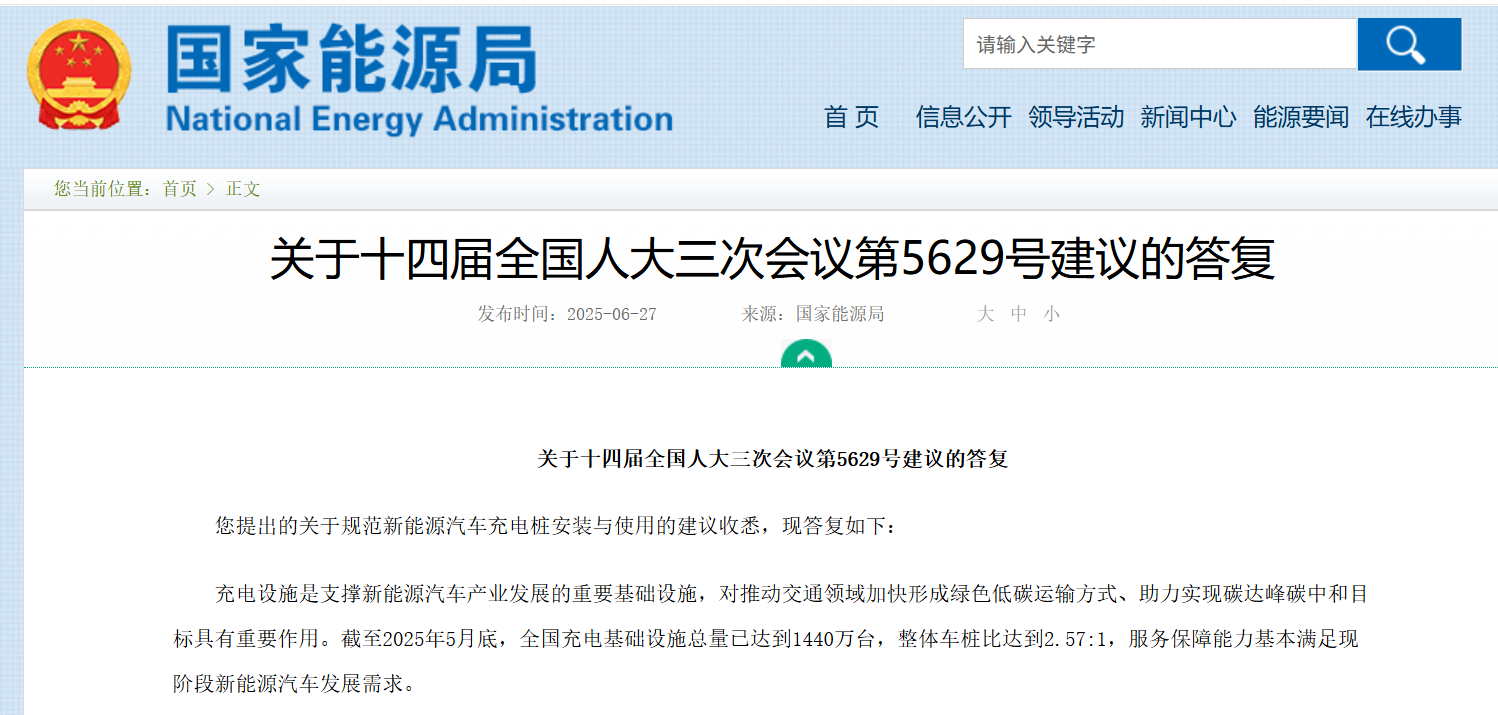The National Energy Administration recently responded to suggestion No. 5629 from the Third Session of the 14th National People's Congress, addressing the installation and usage standards for new energy vehicle charging stations. By the end of May 2025, the total number of charging infrastructure nationwide is expected to reach 14.4 million units, with a vehicle-to-charger ratio optimized to 2.57:1, adequately meeting the current development needs of new energy vehicles. In terms of planning and construction, the National Energy Administration will issue the 'Guidelines for the Layout Planning of Electric Vehicle Charging Facilities' in early 2024 to guide local areas in the proactive planning of charging networks based on the trends in electric vehicle development. Efforts will be made to optimize the scale of construction, network structure, and technical models to promote the formation of an efficient charging service system. The construction of supporting power grids will be strengthened simultaneously, as grid enterprises implement 'three zeros' and 'three reductions' service measures to simplify installation processes and enhance the quality of power access services. The Ministry of Housing and Urban-Rural Development has included the 'number of new energy vehicle charging station shortages' as a basic indicator for urban assessments, accelerating the construction of charging facilities in residential areas in conjunction with the renovation of old communities and the creation of complete neighborhoods. In terms of technology upgrades, support will be given to companies developing efficient, safe, and intelligent charging equipment, promoting new technologies such as wireless charging, and building a national monitoring service platform for charging facilities to enhance operational monitoring capabilities. The management of facilities has been clarified since the 2016 notice issued by four ministries regarding the acceleration of charging infrastructure construction in residential areas, which specifies the responsibilities of property service enterprises to assist in providing plans and on-site inspections. In 2023, the State Council's General Office further refined the guidance on establishing a high-quality charging infrastructure system, proposing the creation of management guidelines for residential area construction at the urban level, optimizing support policies, and establishing grassroots management mechanisms with street and community committees to form a 'one-stop' coordination and complaint resolution system. Currently, the National Energy Administration is working with relevant departments to promote the establishment of clear accountability mechanisms at the local level to ensure policy implementation. In the field of legal protection, the Supreme People's Court is actively implementing the 'green principle' through typical case guidance and business training, clarifying that property service enterprises should facilitate the installation of charging facilities and guiding local courts to detail property cooperation obligations and rules. To address collective disputes, a 'demonstration judgment + mediation' model is being adopted for batch resolution, and in some regions, a normalized dispute resolution mechanism has been established with judicial and housing construction departments, resulting in a continuous decline in property service dispute cases since 2023. Moving forward, the Supreme Court will release typical cases related to charging pile disputes to strengthen the normative guiding role of judicial rulings and effectively protect the legitimate rights and interests of property owners. With collaborative efforts from multiple departments, the charging infrastructure in China is transitioning from a phase of scale expansion to one of quality enhancement. Through scientific planning, meticulous management, and judicial guarantees, the current pain points of installation and usage are being addressed while reserving space for future technological iterations. With the construction of intelligent platforms, the promotion of new technologies, and the improvement of legal dispute resolution mechanisms, the ecosystem for new energy vehicle charging will become more refined, providing solid support for the transition to green and low-carbon transportation methods.
China's National Energy Administration Responds to New Energy Vehicle Charging Standards

Share this post on: